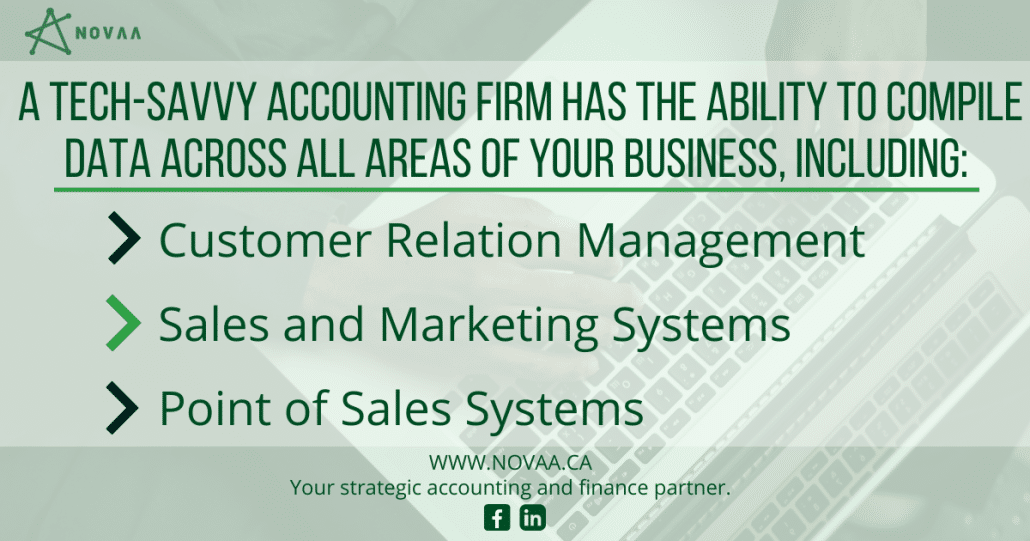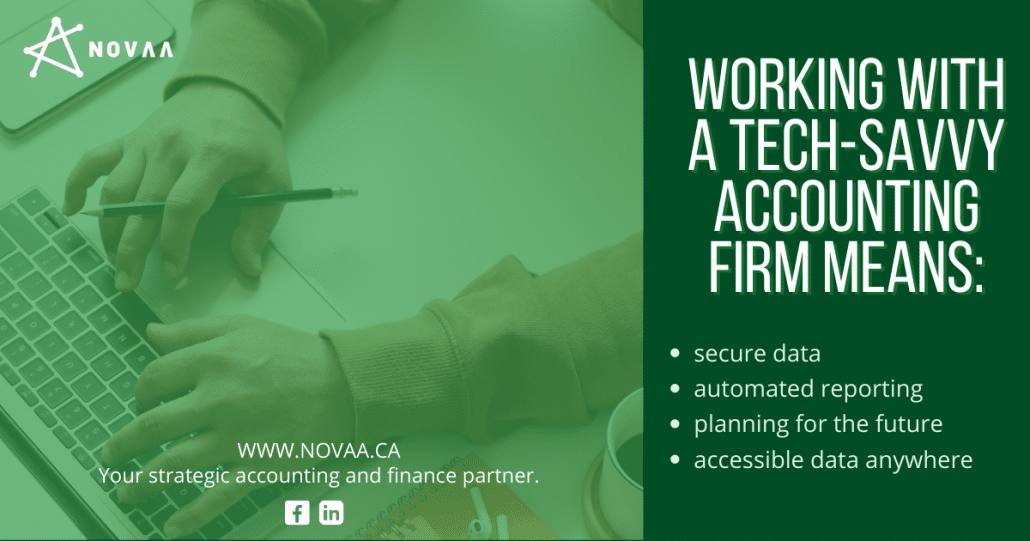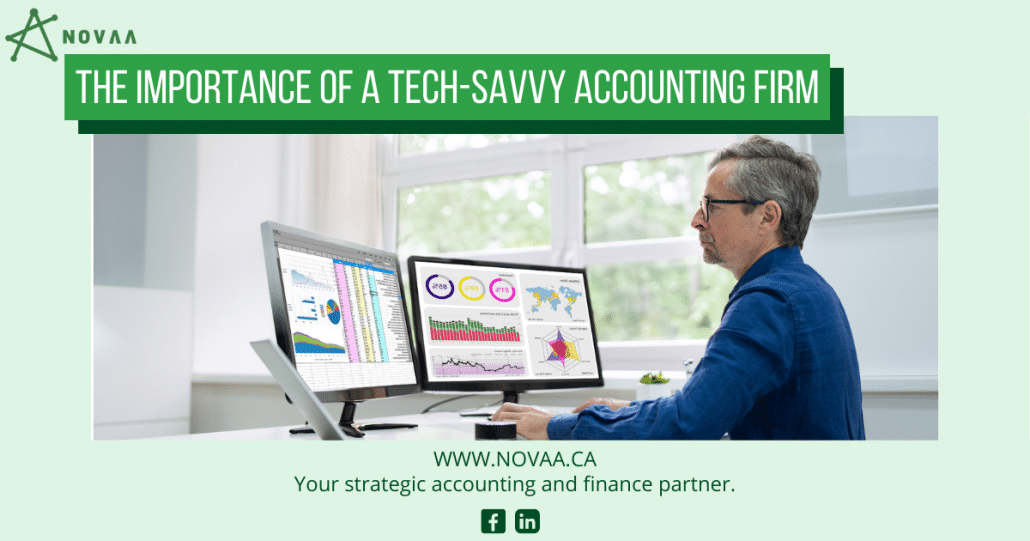The Importance of a Tech-Savvy Accounting Firm
Many businesses are catching on to the upsides of working with a tech-savvy accounting firm.
In fact, an astonishing 78% of business owners say they would prefer to work with a tech-savvy accountant. Why?
Tech-savvy accounting firms, like NOVAA, offer a variety of benefits traditional firms cannot provide. They bring efficiency, accuracy, and smoother processes to your financial systems through in-depth knowledge of third-party applications and financial tools.

With a tech-savvy accountant, your business will be in the right position to reach its financial goals.
How’s that?
Below we will answer a few questions about tech-savvy accounting firms and explain how your business will benefit from one.
What Does a Tech-Savvy Accounting Firm Look Like?

As the name implies, a tech-savvy accounting firm uses the most up-to-date technology to leverage your financial systems and help your business reach its goals.
There are plenty of tools and third-party applications that can be used to improve your financial system and a tech-savvy accountant will have a pulse on the best choice for your business.
They’ll also learn and implement the tools so you don’t have to take the time to do so.
While many tech-savvy accountants have a set of tools they prefer, they are eager to find and learn the next best thing to help move your business forward.
Their pulse on technology extends far beyond financial management, as well. They have the ability to compile data across all areas of your business, including:
- Customer Relation Management (CRM)
- Point of Sales Systems (POS)
- Sales and Marketing Systems
With a culmination of all of this data and their financial expertise, you’ll have everything you need to make the right decisions.
Overall, a tech-savvy accounting firm, like NOVAA, can be a propeller for your business to help it reach its financial goals.
What are the Benefits of Working with a Tech-Savvy Accounting Firm?
As opposed to a traditional firm, you’ll notice tech-savvy firms look more towards the future, prioritize efficiency, and ease your financial management role.
Let’s dive into the specific benefits of working with a tech-savvy accounting firm.
A Tech Stack Built for Your Business
Automation is the key to building a financial system centered around technology. However, the tools you choose and how those tools work together is the deciding factor between whether or not your automation helps your business achieve its goals.
One of the first things a tech-savvy accountant will do to improve your financial system is build a tech stack. A tech stack is a combination of all of the automation tools that work together to electronically manage your finances.
This includes everything, like:
- Bookkeeping
- Managing accounts receivables
- Tracking payroll
- Inventory management
- Bill paying
A well-built tech stack can completely eliminate manual work, produce up-to-date data, and simplify your day-to-day management responsibilities.
Efficiency
With your new tech stack and tech-savvy accountant, you’ll see noticeable improvements in efficiency.
As mentioned, there will be little to no manual work required to manage your finances. All of your data will be up-to-date and accessible from anywhere which allows your accountant to work quickly, generate reports, spot trends, and so much more with just a few clicks of a button.
Fewer Errors
To no one’s fault, manual work is prone to errors. At the very least, these errors are time-consuming and their worst are very costly.
Fewer (to almost zero) errors are a byproduct of working with a tech-savvy accountant. Again, automation is the key to this benefit.
Applications can transfer one data entry to multiple platforms seamlessly. There is no looking up information and duplicating records to gain a better grasp of your numbers. Everything is calculated for you.
This also means your accountant can dig deeper into your numbers without guessing if the data is accurate.
Accessibility
Working with automated tools also leads to improved accessibility, not just for your accountant but also for you.
While your tech-savvy accountant will obviously have access to your tools, so will you. This means you can access your accounts from anywhere to gain insight into your numbers.
Sharing files, emails, and lost papers become a thing of the past. All of the financial information you and your accountant need to manage your finances and run your business will be available 24/7, from everywhere.
Future-Focused Strategies
With the benefits of efficiency, accuracy, and accessibility your accountant will have everything they need to focus on the future.
They will be able to compile data to create strategies that will move your business forward. This also includes a detailed budget and forecasts.
Together, you’ll be able to use these to create future-focused strategies.
Easier Collaboration
The automated tools your tech-savvy accountant implements will lead to improved collaboration between your internal and external teams.
All of your data and documents will be centralized and there will be no need for emailing back and forth or checking to see if the information is up-to-date before moving forward. You and your accountant can have confidence in the accuracy of your data and your workflow processes will improve.
You will both always be on the same page.
Less Work For You
Less work for you is a benefit of working with any accountant, not just a tech-savvy one.

However, when your accountant is tech-savvy, your systems will be automated (as we mentioned) and you will not be required to manually update data or send information to your accountant.
They will have everything they need and will:
- Create reports
- Build a budget
- Create forecasts
- Meet deadlines
- Spot negative trends and suggest improvements
- Create short and long-term strategies for meeting your goals
All of the financial management tasks that take your time and brain power will go to your tech-savvy accountant.
Improve Security
When you or your accountant rely on manual management, security becomes a huge risk. Files can get lost, deleted, accessed by unauthorized viewers, or corrupted. All of these can be costly for your business and lead to plenty of issues down the road.
With technology infused into your financial system, your work will automatically be saved and stored. Only the people you’ve allowed permission will have access and your information will be safe.
Additionally, these tools are often heavily encrypted so the potential for hacking is near impossible.
With the help of a tech-savvy accountant, you can rest easy knowing your essential information is safe and secure.
Searching for a Tech-Savvy Accounting Firm?
Technology has allowed accountants to do their job better, and in doing so, provide better services to their clients.
Partnering with a tech-savvy accounting firm is one of the best ways to position your business for long-term success.
At NOVAA, we pride ourselves on being a tech-savvy accounting firm. We take time to learn your business and then get to work finding ways to improve your finances through efficiency, accuracy, and smoother processes.
We start with building a tech stack and then begin suggesting and implementing strategies – based on your historical data and our experience – that focus on helping your business reach its goals.

If you’re looking for a tech-savvy accounting firm, contact NOVAA today! We’d love to help your business every step of the way!











